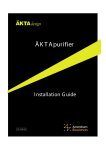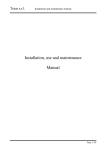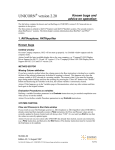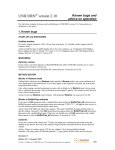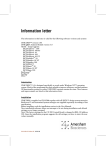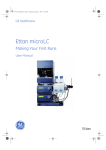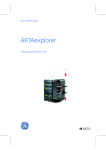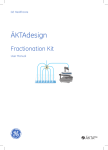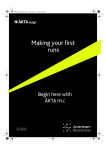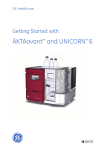Download Making your first run - GE Healthcare Life Sciences
Transcript
18-1120-02_ac.qxd 1998-10-23 11:28 Sida 1 (1,1) Making your first run Begin here with ÄKTApurifier 10/100 18-1120-02 18-1120-02_ac.qxd 1998-10-23 11:28 Sida 2 (1,1) Important us er information ! Trademarks ÄK T A and UN IC O R N are trademarks of A mersham Biosciences L imited or its subsidiaries. M eaning: C onsult the instruction manual to avoid personal injury or damage to the product or other equipment. A mersham Biosciences is a trademark of A mersham plc. WA R N IN G ! T he Warning sign is used to call attention to the necessity to follow an instruction in detail to avoid personal injury. Be sure not to proceed until the instructions are clearly understood and all stated conditions are met. W indows is a trademark of M icrosoft C orp. C A U T IO N ! T he C aution sign is used to call attention to instructions or conditions that shall be followed to avoid damage to the product or other equipment. Be sure not to proceed until the instructions are clearly understood and all stated conditions are met. N ote T he N ote sign is used to indicate information important for trouble-free or optimal use of the product. Should you have any comments on this instruction, we will be pleased to receive them at: A mersham Biosciences SE –751 84 Uppsala Sweden Terms and C onditions of S ale A ll goods and services are sold subject to the terms and conditions of sale of the company within the A mersham Biosciences group which supplies them. A copy of these terms and conditions of sale is available on request. A dres s es A mersham Biosciences U K L imited A mersham Place L ittle C halfont Buckinghamshire E ngland H P7 9N A A mersham Biosciences SE -751 84 Uppsala Sweden A mersham Biosciences 800 C entennial Avenue PO Box 1327 Piscataway N J 08855 USA © A mersham Biosciences 1998 – A ll rights reserved 18-1120-02_ac.qxd 1998-10-23 11:28 Sida i (1,1) Contents Contents 1. About this guide ......................................................1 2. The system and the software ................................3 3. Creating a method ................................................11 4. Preparing the system for a run ............................18 5. Starting a run ........................................................20 6. Viewing a run ........................................................23 7. Viewing and printing the result............................25 8. BufferPrep and Scouting ......................................30 9. Going further ........................................................33 Short instructions on back page Making your first runs 18-1120-02 Edition AC i 18-1120-02_ac.qxd 1998-10-23 11:28 Sida ii (1,1) Contents ii Making your first runs 18-1120-02 Edition AC 18-1120-02_ac.qxd 1998-10-23 11:28 Sida 1 (1,1) 1 About this guide 1. About this guide This guide is written for users who are not familiar with UNICORN™ software and ÄKTA™purifier. Here you will learn the basics of UNICORN and how to operate ÄKTApurifier from UNICORN. UNICORN is a software package for control and supervision of the ÄKTApurifier chromatography system. It runs on an IBMcompatible PC under Windows™ NT, and includes hardware for interfacing the controlling PC to the chromatography liquid handling parts of ÄKTApurifier In this guide you will learn how to: • create methods • prepare the system for runs • perform runs • make simple evaluations • make reports • perform automatic method optimisation (Scouting) • prepare automatically buffers of any pH (BufferPrep) Follow the guide from page to page in front of the computer. The time will be well spent. Note: To follow the instructions it is not necessary to read the comments (written with smaller font) containing additional information. Making your first runs 18-1120-02 Edition AC 1 18-1120-02_ac.qxd 1998-10-23 11:28 Sida 2 (1,1) 1 About this guide Pre-requisites The system and the software must be installed and functioning and the monitor and pump calibrated as described in the separate Installation guide. IMPORTANT! Before using ÄKTApurifier, read all the safety information in Section 1.2 in ÄKTApurifier System Manual. Typographical conventions Menu commands and dialogue box prompts are identified in the text by bold text. A colon separates menu levels, thus File:Open refers to the Open command in the File menu. 2 Making your first runs 18-1120-02 Edition AC 18-1120-02_ac.qxd 1998-10-23 11:28 Sida 3 (1,1) The system and the software 2 2. The system and the software ÄKTApurifier ÄKTApurifier is a fully automated liquid chromatography system designed for method development and research applications. The separation unit of the chromatography system has three main modules which are stacked on the left-hand side of a base platform. They are: • Pump P-900, a family of binary high performance gradient pumps. - In ÄKTApurifier 100 the flow rate is up to 100 ml/min and the pressure up to 10 MPa (pump designation is P-901). - In ÄKTApurifier 10 the flow rate is up to 10 ml/min and pressure up to 25 MPa (pump designation is P-903). • Monitor UV-900, a multi-wavelength UV-Vis monitor for simultaneous monitoring of up to 3 wavelengths in the range 190-700 nm. • Monitor pH/C-900, a combined monitor for on-line conductivity and pH monitoring. Fraction collector Frac-900 (optional) is placed to the right of the system. Up to 175 fractions can be collected. pu ri ÄKTA Making your first runs 18-1120-02 Edition AC fier 3 18-1120-02_ac.qxd 1998-10-23 11:28 Sida 4 (1,1) 2 The system and the software Components, such as the mixer, column and different valves, are mounted in the section to the right. The separation unit is controlled from UNICORN software. Column holder Column Injector valve INV-907 Box-900 Monitor pH/C-900 INV-908 Outlet valve PV-908 On-line filter Monitor UV-900 To Fraction collector PV-908 Purge valve tubing Flow restrictor Mixer chamber Mixer M-925 Pump P-900 (P-901/903) M-925 To waste flask (W1, W2 and W3) ON/OFF button Conductivity cell (below lid) Switch valve A SV-903 Switch valve B SV-903 UV flow cell Pump P-900, Monitor UV-900 and Monitor pH/C-900 can also be controlled individually from the modules, without UNICORN software. In this guide, however, you will only learn how to operate the chromatography system from UNICORN. Switch on the chromatography system with the ON/OFF button located on the front of the base platform to the bottom left. 4 Making your first runs 18-1120-02 Edition AC 18-1120-02_ac.qxd 1998-10-23 11:28 Sida 5 (1,1) The system and the software 2 Comment: The flow path between the different components in the system is shown and described below. It is not necessary to go through this in detail to make your first runs. Look to the right-hand side of the system if you want to follow the description. Column System pump Mixer Sample Injection Monitoring Fractionation UV-monitor Conductivity monitor Flow restrictor On-line filter Outlet valve pH-monitor (Optional) Switch valves Waste Flowthrough A1 A2 B1 B2 Fraction collector Waste 1. The pump has 4 pump heads, two for pump A and two for pump B. Pump A is the one closest to the front. 2. The buffer solutions are pumped through switch valves, and further to a mixer. Inlet A1 and B1 are placed in buffer A and B respectively. Inlet A2 and B2 are used when buffers are prepared automatically by BufferPrep. 3. The flow path continues from the pump to the mixer, and forward via an online filter to the injection valve. 4. A sample loop is connected between ports 2 and 6 on the injection valve. The sample loop is filled manually using a syringe; for this procedure, connect a fill port to port 3 on the injection valve. 5. After the injection valve, the flow is directed to the column, and then forward to the UV cell and the conductivity cell, which are located inside the cell holder on Monitor UV-900. 6. The flow path continues to the flow restrictor (and through the pH flow cell, if fitted (optional), and further to the outlet valve, which is used to switch the outlet flow between waste, fraction collection and flowthrough. 7. The flow path can continue to a fraction collector (optional), if desired. Making your first runs 18-1120-02 Edition AC 5 18-1120-02_ac.qxd 1998-10-23 11:28 Sida 6 (1,1) 2 The system and the software UNICORN overview 1 Switch on the computer. Log in to Windows NT 4 by first pressing Ctrl-Alt-Del, and then clicking on OK. After a while the Windows NT 4 desktop appears. 2 Start UNICORN by double-clicking on the UNICORN icon. 3 Select a user from the Users: list and enter the password. If you log in for the very first time, select user default and enter the password default. Click on OK. Note: You should enter users and individual passwords before starting using ÄKTApurifier on a regular basis. 4 An information window appears during start-up. 6 Making your first runs 18-1120-02 Edition AC 18-1120-02_ac.qxd 1998-10-23 11:28 Sida 7 (1,1) The system and the software 2 5 Eventually, the UNICORN Main menu window appears on the screen. At delivery, a Toolbar guide is displayed providing a quick guide on how to use the toolbar items. The Toolbar guide is inhibited by unchecking the square at the bottom left. Click on Close. 6 The Main menu window is the central part of UNICORN displays from which you navigate through the control system. It is mainly used for file handling. In the Methods window to the left in Main menu, all method files that you create are displayed. A method file contains a series of instructions for controlling a run. In the Results window to the right, all result files are displayed. A result file is the result from a run, including all documentation (e.g. the method used) and the generated chromatogram. Making your first runs 18-1120-02 Edition AC 7 18-1120-02_ac.qxd 1998-10-23 11:28 Sida 8 (1,1) 2 The system and the software In general, UNICORN consists of 4 different modules of which the Main menu is one. The other modules are represented by icons in the Toolbar. These modules are: • New method opens a dialogue window for creating new methods. • System control opens a dialogue window for controlling the system and running your methods. • Evaluation opens a dialogue window for evaluating your results. A module is opened by clicking on its icon. An additional three buttons are provided in the Toolbar. These are: • Instant run opens a dialogue window where you directly can choose a template method to run. This is handy for starting routine runs instantly. • Logon/Logoff opens a dialogue window to control the logon/logoff process. • about UNICORN opens an information window about the UNICORN version and how to contact Amersham via the world wide web (internet). 8 Making your first runs 18-1120-02 Edition AC 18-1120-02_ac.qxd 1998-10-23 11:28 Sida 9 (1,1) The system and the software 2 Help and Adviser Comprehensive on-line help is available. Click on the Help menu in the upper right corner of each module and select Help for ......... to get general help about the current module and find new help topics, or Help Index for a specific topic. Double-click on green text to get more help. In any box, click on the Help menu to get help on how to use the current active box. Click on Adviser in the menu bar, and choose the appropriate system to get help about separation optimisation protocols (Method Adviser), detailed information about chromatographic columns (Media Adviser), and information about ÄKTApurifier (System Adviser). Making your first runs 18-1120-02 Edition AC 9 18-1120-02_ac.qxd 1998-10-23 11:28 Sida 10 (1,1) 2 The system and the software 10 Making your first runs 18-1120-02 Edition AC 18-1120-02_ac.qxd 1998-10-23 11:28 Sida 11 (1,1) Creating a method 3 3. Creating a method UNICORN is supplied with a number of almost ready-made methods called method templates. Different method templates are available for different chromatographic techniques. The method templates can be run as they are or you can easily modify them to design your own method in a very short time. Let's start! 1 Click on in the Main menu Toolbar. The New Method window will appear. Select system Select technique Select template Select column Press OK 2 Select a system. Then select a chromatographic technique, for example Anion_Exchange. 3 A list of available templates will appear. By clicking on a template, an explanation for the template appears to the right in the "Method Notes" field. Select the template Man_f_gr, which is suitable for the first run. Comment: The other templates are briefly described at the end of this chapter. 4 Select the column you intend to use. The correct column volume, the recommended flow rate, and the correct pressure limit for that column will then be automatically implemented in the method. Comment: If you manually alter the default values, and thereby exceed the recommended values for the selected column, you will get a warning when you save your method. Making your first runs 18-1120-02 Edition AC 11 18-1120-02_ac.qxd 1998-10-23 11:28 Sida 12 (1,1) 3 Creating a method If you want to perform a test run without a column, you should still select a column (a small one is recommended) to get suitable default parameters in the method. Then in the method, use a peice of tubing to replace the column. Comment: If you do not find your column in the list, you can add one. See section 5.9 in UNICORN User Manual. 5 Click on OK. The method template will now be opened as an untitled method. 6 Select View:Run setup (may already be checked). Click here to select page Block names Blocks Click here to see the next part of the Variables page Method variables 7 Run setup consists of a number of pages. You will only look at two of them now; Variables and Notes. You select a page by clicking on the respective tab at the top of the run setup screen. 8. On the Variables page, the method is presented by a number of blocks (name in blue). The blocks represent the typical steps in a chromatographic run: - Start conditions - Column equilibration - Flow through collection - Sample injection - Wash out unbound sample - Eluate fractionations 12 Making your first runs 18-1120-02 Edition AC 18-1120-02_ac.qxd 1998-10-23 11:28 Sida 13 (1,1) Creating a method 3 - Gradient - Clean after gradient - Reequilibration Each block contains a number of method variables (name in black) with suitable default values. The values are easily changed to suit your requirements. Click on the scroll bar to see the next part of the Variables page. The only values you must change in the man_f_gr template are for: • Empty_loop_with, in the block Sample_Injection Enter a value of 5 x the volume of the sample loop to apply all the sample onto the column. • Flowthrough_FracSize, in the block Flowthrough and Fractionation Enter a suitable fraction size. The fraction collection starts at injection and continues until gradient start. Zero means that fractions will not be collected. • Eluate_FracSize, in the block Start Fractionation Enter a suitable fraction size. The fraction collection starts at the beginning of the gradient. Zero means that fractions will not be collected. Making your first runs 18-1120-02 Edition AC 13 18-1120-02_ac.qxd 1998-10-23 11:28 Sida 14 (1,1) 3 Creating a method Comment: Each method template is unique, but they are all built up with the same principle. Below is a description of all the blocks in the man_f_gr template • Main The column selected is shown here. • Start conditions GR Enter the wavelengths at which the run should be monitored. The UV averaging time is automatically set to a default value for the column selected. The pressure limit is automatically set to a default value for the column selected. • Initial eluent condition GR Select the inlet for eluent A (usually A1). Select the inlet for eluent B (usually B1). Select the start concentration of eluent B (usually 0%). If a BufferPrep template is used (xxx_yy_AX or xxx_yy_CX, see Section 8) the pH can be entered here. Otherwise it should be zero. The flow rate is automatically set to a default value for the column selected. If you manually alter default values, and thereby exceeding the recommended values for the selected column, eventually you will get a warning when you save your method. Please note that the total setting range shown within brackets for the method variables is for your information only, to state the valid range for the variables. • Column equilibration The number of column volumes (CV) necessary to equilibrate the column is set here. If you are using ÄKTApurifier 10 and zero is entered, no equilibration will take place. If you are using ÄKTApurifier 100, a sub block called System_volume_compensation is included. This block adds 8 ml of equilibration to compensate for the system gradient delay volume. This facilitates to accomplish comparable results when scaling up from small columns. • Flowthrough fractionation The flowthrough fractionation starts at sample injection and continues to the start of the gradient. If not fractionated, the flowthrough will be collected in position F3 of the Outlet valve. • Sample injection To apply all the sample onto the column, empty the sample loop with a volume 5 x the volume of the sample loop. • Wash out unbound sample To wash out unbound sample with the starting buffer, enter the length of the wash here. • Eluate fractionation By default, the fraction collection will start at the beginning of the gradient. To start eluate fractionation later than the gradient start, set Start_Frac_at to the desired ConcB value. 14 Making your first runs 18-1120-02 Edition AC 18-1120-02_ac.qxd 1998-10-23 11:28 Sida 15 (1,1) Creating a method 3 • Start fractionation Set the fraction size used during elution. Zero means that fractionations will not be collected. To end the fractionation earlier than the gradient end, set End Frac_at to the desired ConcB value. • Gradient segment 1-3 The target concentration of eluent B and the length of the gradient is set here. A linear gradient is developed from the initial ConcB value (Start_ConcB) to the Target_ConcB_1 value (default=100%) for the duration of Length_of_gradient_1 in column volumes. Two additional gradient segments can be defined. • Clean after gradient The concentration of eluent B necessary to clean the column after the separation is set here (usually 100%). The length of cleaning is also set here. • Reequilibration GR The number of column volumes necessary to reequilibrate the column is set here. If zero is entered, no reequilibration takes place. . Making your first runs 18-1120-02 Edition AC 15 18-1120-02_ac.qxd 1998-10-23 11:28 Sida 16 (1,1) 3 Creating a method 9 Click on the “Gradient” page to view the method graphically. The length of each block is marked at the bottom of the graph. Click in the graph. The name of the block at that position is shown in the upper part of the chromatogram. Click on the x axis to view the method in time, volume or column volumes. 10 Click on the Notes page. Maximise the method notes field with the button to the right of the field. The method notes contain comments and information about the method, e.g. how sample injection, fractionation and elution are performed. 16 Making your first runs 18-1120-02 Edition AC 18-1120-02_ac.qxd 1998-10-23 11:28 Sida 17 (1,1) Creating a method 3 11 Select File:Save. Enter a name. Store the method in the directory of your choice by double-clicking on a directory. Click on OK. Comment: The method name, followed by two consecutive numbers starting with 01 will then be used as default name for the result file of your method after runs. 12 You have now created a method. 13 Click on the Main menu icon at the bottom of the screen. Your saved method appears in the window to the left. Now you are ready to start a run. Go to chapters 4 and 5. You can also go to chapter 8 to learn how to vary any variables systematically and automatically in repeated runs. This is know as scouting and is a convenient, easy to use function. Comment: If you want a more flexible method, once you are used to the basic template, select File:New in the method editor, and one of the more advanced templates. The template man_f_gr is similar to the basic_gr template, but allows more flexibility such as segmented gradients and flexible start of fraction collection in the gradient. Some of the more advanced templates are named according to the following abbreviations (xxx_y_zz). Note: Some of the functions indicated below are unic för a specific system and may not be included in the templates supplied with your system. The first three letters (xxx) identify the type of sample application used: man = the sample loop or Superloop is filled manually with a syringe sys = the sample is applied directly through the pump The letter in the middle (y) identifies the type of fractionation used: f = fraction collection of fixed volumes p = fraction collection of peaks v = valve fractionation of fixed volumes The last two letters (zz) only identify the technique for which the template is written. gf = gel filtration ac = affinity chromatography ax = anion exchange with BufferPrep cx = cation exchange with BufferPrep gr = gradient without BufferPrep A CIP (Cleaning in place) template is also available. It enables automatic cleaning of the column with up to 4 different solutions. All xxx_y_ax and xxx_yy_cx templates are pre-defined for BufferPrep (automatic buffer preparation), which allows pH scouting (see section 8 for further details). In ÄKTApurifier 10 there are also basic templates for each one of the ..._zz templates. These templates are sligthly simplified versions of the more comprehensive xxx_y_zz versions. Making your first runs 18-1120-02 Edition AC 17 18-1120-02_ac.qxd 1998-10-23 11:28 Sida 18 (1,1) 4 Preparing the system for a run 4. Preparing the system for a run System connection If the text “NO” is written in the Connection panel in the Run Data window, follow the instructions in the comment below. If not, go directly to “General system preparation”. Comment: Before you can start a run, you must always connect to the system. Connecting means that the System Control window is set up for a particular system. If you are not connected, the text “NO” is written in the Connect panel in the Run Data window. Once you are connected, the text changes to “YES”. 1 Click on the System Control icon. The System connect dialogue window appears: 2 Select a system from the list. If you are not connected to a network, only one system will be shown. Click on OK. 3 When connected, the text “YES” is written in the Connect panel in the Run Data window. You only have to connect once. If you do not select System:Disconnect, you will be automatically connected to the system the next time you login to UNICORN . General system preparation 1. The correct tubings (0.25, 0.50 or 0.75 i.d. mm) for the column you intend to use must be installed. See Section 2.1 in ÄKTApurifier System Manual for an overview over columns with recommended tubings. For most columns the tubings mounted from the factory can be used. Comment: If tubing with too large inner diameter are used, the peaks will become broader than necessary. If tubing with too small inner diameter are used, the backpressure from the tubing might become higher than the max. pressure for the column and the run will stop immediately after it is started. 2. Immerse inlet tubing A1 (or A2 if you changed this in the method) in buffer A and inlet tubing B1 in buffer B. 3. Put the waste tubing from port 1 of the outlet valve into a waste 18 Making your first runs 18-1120-02 Edition AC 18-1120-02_ac.qxd 1998-10-23 11:28 Sida 19 (1,1) Preparing the system for a run 4 bottle. Check that the tubing from port 2 of the outlet valve is connected to the fraction collector (if used). The flowthrough will be collected via the tubing F3 from port 3 of the outlet valve, or, if you enter a value for Flowthrough_FracSize, in the fraction collector. 4. If there is air in the inlet tubing or if you suspect air in the pump, purge the pump with a syringe as described in section 2.8 in Pump P-900 User Manual. 5. Calibrate the pH monitor (optional) if required. Refer to Section 6.6 in UNICORN 3.0 User Manual or Section 3.6 in Monitor pH/C-900 User Manual. 6. Connect the column between port 1 of the injection valve and the top of the UV flow cell. Use a suitable length of 0.25 mm PEEK tubing (blue) supplied with your system. INV-908 PV-908 7. Insert a sufficient number of tubes into Frac-900 (optional) and place the arm at the first tube. 8. Double-click on the System Control icon. Fill the inlet tubing with the correct solutions by selecting Manual:Pump. Then select instruction PumpWash. Select ON for Inlet A1 and set Inlet A2 to OFF. Select ON for Inlet B1 and OFF for Inlet B2. Click on Execute to fill the inlet tubing. The injection valve will switch to waste during the pump wash. Then click on Exit. 9. Connect an injection fill port or a union luer female/1/16” male to port 3 on the injection valve and apply the sample manually with a syringe. 3 Making your first runs 18-1120-02 Edition AC 19 18-1120-02_ac.qxd 1998-10-23 11:28 Sida 20 (1,1) 5 Starting a run 5. Starting a run 1 Click on the System Control icon if it is not open. 2 Select File:Run... Select the method to start. Click on Run (the method will not start yet). 3 A Start protocol appears consisting of a number of pages. 4 The first page you see is Variables. This is the same page you were working on in the method editor. Here you can fine tune the method before starting it. This is very convenient when repeating runs with minor adjustments. Comment: When starting run no. 2 immediately after run no. 1 with the same method but, for example, a different flow rate, you simply: 1 Click on the Run button in System Control. 2 Change the flow rate on the Variables page 3 Continue through the start protocol by clicking on Next and then start the run. You do not need to change the method in the Method editor 5 Go through the Variables page to check that the method is OK (this is not necessary if this was done in the method editor). 6 Click on the Next button at the bottom of the window; this takes you to Questions. Enter the answers to the questions. The answers will be saved in the result file. Some questions may have been defined as mandatory (mand). These must be answered before the run can be started. 20 Making your first runs 18-1120-02 Edition AC 18-1120-02_ac.qxd 1998-10-23 11:28 Sida 21 (1,1) Starting a run 5 7 Click on Next. This takes you to Notes. You can write your own comments in the Start notes. 8 Click on Next. This takes you to Evaluation Procedures. Evaluation Procedures are automated evaluation operations that are performed after the run. Mark Print_Chromatogram. The chromatogram will then automatically be printed after the run. Making your first runs 18-1120-02 Edition AC 21 18-1120-02_ac.qxd 1998-10-23 11:28 Sida 22 (1,1) 5 Starting a run 9 Click on Next. This takes you to Method Information. Here you see information about the run. The approximate volume of buffer used (A+B) is shown as well as how long the method will take. 10 Click on Next. This takes you to Result Name. Here you name the result file and define in which directory the result should be stored. A default name (the method name followed by 01) and a directory are suggested. But you can change the result name and directory (click on Browse...) if you so wish. 11 Click on START. The run will start. 22 Making your first runs 18-1120-02 Edition AC 18-1120-02_ac.qxd 1998-10-23 11:28 Sida 23 (1,1) Viewing a run 6 6. Viewing a run When the system pump is running, the text “Run” is shown in the Run Status panel in the Run Data window. 1 Select View:Windows. Check Rundata, Curves and Logbook. Click on OK. 2 The Run Data window at the top shows current values for running parameters. 3 Position the cursor in the Run Data window. Click on the right mouse button and select Properties.... Now you can select which parameters you want to see in the Run Data window. For eaxample, select Acc. time, Block time, flow and pressure. Click on OK. 4 The Curves window shows the curves during the run. 5 Position the cursor in the Curves window. Click on the right mouse button and select Properties.... Here you can select which curves to show during the run. All curves are stored in the result file. Making your first runs 18-1120-02 Edition AC 23 18-1120-02_ac.qxd 1998-10-23 11:28 Sida 24 (1,1) 6 Viewing a run 6 By clicking the different tabs in the Curve Properties window you can set the properties for the different curves. Normally the curves are scaled with auto scaling, i.e. the scale is adjusted continually to the highest and lowest values for each curve. 7 To fix the Y-axis scale for a curve, mark the curve, click on Y-axis, click on Fixed, and enter the max. and min. values. You can repeat this for other curves. Click on OK. 8 To maximise the Curve Data window, Position the cursor in the Curve Data window. Click on the right mouse button and select Maximize. Go back to normal size by clicking on Restore. 9 Click on the Y-axis scale, or click on the curve name at the top of the Curve Data window to shift to a scale for another curve. The colour of a curve, its Y-scale, and its name are always the same. Click on the X-axis to shift between time and volume. 10 The Logbook is shown at the bottom. The Logbook shows exactly when the instructions in the method are executed during the run. The Logbook is stored in the result file. 11 You can make manual changes during the run. Select Manual:Pump. The Instructions box is opened. 12 If, for example, you want to change the flow rate, select Pump and then Flow. Enter a new flow rate under Parameters and then click on Execute. The new flow rate will be used until the end of the run or until a new flow rate instruction is reached in the method. Close the box by clicking on Close. All manual interactions are recorded in the Logbook. 13 If you want to stop the run before it is finished, click on the End button at the top. 24 Making your first runs 18-1120-02 Edition AC 18-1120-02_ac.qxd 1998-10-23 11:28 Sida 25 (1,1) Viewing and printing the result 7 7. Viewing and printing the result If you are satisfied with the automated printout obtained after the run (if selected), you need not alter anything described in this section. However, if you want to alter the chromatogram layout, this section will teach you the basics of the evaluation module. Viewing 1 After a run you can view the result. Click on the Main menu icon. Double-click on a result file icon in the list to the right. 2 The Chromatogram window is opened automatically in the Evaluation workspace when you open a result file. The Chromatogram window contains all the curves. Note that the term chromatogram is used here when talking about the whole window containing all the different curves. Chromatogram window The result file from a run holds a complete record of the run, including method, system settings, curve data and run log. It is accessed by clicking the Documentation button. Comment: Original raw data curves can never be modified, renamed, or deleted from a result file. Making your first runs 18-1120-02 Edition AC 25 18-1120-02_ac.qxd 1998-10-23 11:28 Sida 26 (1,1) 7 Viewing and printing the result 3 Maximise the Chromatogram window by clicking on the larger square in the upper right corner. 4 All changes regarding the presentation of the curves are done in the Chromatogram Layout window. Position the cursor in the Chromatogram window. Click on the right mouse button and select Properties...., or select Edit:Chromatogram layout... to activate this window. Highlight curves to view 5 Highlight the curves to view under Curves. Curves are named as Resultfile:1_"curve" where a curve can be, for example, UV_wavelength, Cond, pressure ...etc. De-select all curves except, for example, the UV, Cond and Conc. curves. Click on OK at the bottom of the Chromatogram Layout window. 6 You can easily zoom in on the curves. Place the cursor in the chromatogram, click on the mouse button and holding it pressed down, move the mouse. A rectangle appears on the screen. When you release the mouse button, the part within the rectangle will be enlarged. You can zoom further on the enlarged part. Click on the right mouse button and select Undo or Reset zoom to return to the complete chromatogram. 7 Click on the Y-axis scale to change to a scale for another curve. The style and colour of a curve, its Y-scale and its X-scale can all be changed. 26 Making your first runs 18-1120-02 Edition AC 18-1120-02_ac.qxd 1998-10-23 11:28 Sida 27 (1,1) Viewing and printing the result 7 8 Open the Chromatogram Layout window again. Click on the Y-axis and X-axis tabs to set the scale for the different curves. Normally, the curves are scaled with auto scaling, i.e. the highest and lowest values for each curve set the scale. 9 To fix the Y-axis scale, mark a curve, click on Fixed, and enter the max. and min. values for that curve. You can repeat this for other curves. 10 To fix the X-axis scale, click on Fixed in the X-axis field, and enter the min. and max. values for the X-axis. Click on OK. 11 Click on OK at the bottom of the Chromatogram Layout window to execute all the changes. Comment: When you have made the necessary changes in the Chromatogram layout box, they can be saved as a Layout. Click on the Save as button at the top of the Chromatogram layout box to save the layout. Give the layout a name and click on OK. Layouts can be selected in Apply layout at the top of the box and all your saved selections will apply. Saved layouts can be applied to any result file. 12 Minimise the chromatogram window by clicking on the smaller squares in the upper right corner. 13 Click on the Documentation button. A number of pages appear as in the Run Setup in the Method Editor. All documentation about the run is stored here, e.g. the method, answers to questions, variables, logbook ...etc. For example, click on the Notes and Logbook pages to check the contents. Close the Documentation window by clicking on the X in the upper right corner. Making your first runs 18-1120-02 Edition AC 27 18-1120-02_ac.qxd 1998-10-23 11:28 Sida 28 (1,1) 7 Viewing and printing the result Printing and making a report 1 The quickest way to print out the chromatogram as it appears on the screen is to select File:Print.... 2 To include more information in the report, select File:Report.... 3 Under Report contents, select which main items to include. For example, select only Header and Chromatogram. Indicates that items for Header are shown to the right Items included in Header Main items to include in the report 4 Check and select the contents in Header by clicking on the radio button beside Header. Select what you want to include from the panel to the right. Comment: You can mark items in the right-hand panel regardless of whether the corresponding Report Contents heading is selected (ticked) or not. Only the selected items for which the Report Contents headings are ticked will be printed. 5 Click on the radio button beside Chromatogram and select Current Chromatogram. The current chromatogram is the one you have open on the screen. In the next step you will select which curves to print. Remember that the term chromatogram refers to the whole chromatogram window and not to individual curves. Comment: Select All chromatogram if you have many chromatogram windows on the screen and want to print them all. 28 Making your first runs 18-1120-02 Edition AC 18-1120-02_ac.qxd 1998-10-23 11:28 Sida 29 (1,1) Viewing and printing the result 7 Indicates that items for Chromatogram are shown to the right Define button Current button 6a To print the current chromatogram as it looks on the screen, click on the Current button below the list (to get the current layout). 6b If you want to change the layout, click on the Define button. The Chromatogram Layout window is opened and you can select curves and change the layout of the chromatogram just as you did in the previous section. Mark which curves to print. Click on the Header button. The information selected here will be printed on top of the chromatogram. Select Variables and/or Questions. Click on OK. Click on OK at the bottom of the Chromatogram Layout window. Comment: The changes made here in the Chromatogram Layout window will only affect the printout and not the presentation of the chromatogram on the screen. 7 Click on Preview to view the report on the screen. Click on Print and the report is printed. Making your first runs 18-1120-02 Edition AC 29 18-1120-02_ac.qxd 1998-10-23 11:28 Sida 30 (1,1) 8 BufferPrep and Scouting 8. BufferPrep and Scouting The BufferPrep function allows a buffer of any pH to be prepared on-line from four stock solutions. The pH can be varied automatically between scouting runs to find the optimal pH for the separation. A pH electrode is not necessary to obtain correct pH using BufferPrep. For more details about BufferPrep see Section 2.7 in ÄKTApurifier System Manual. Scouting allows any run parameters, e.g. pH, to be systematically varied automatically, in repeated runs. Below is a description of how to perform a pH scouting. 1. Select File:New:Method in Main menu. Select system. Then select Anion exchange as technique. 2. Select template man_f_ax. Select a column and click on OK. Comment: BufferPrep can be used with all xxx_yy_ax and xxx_yy_cx templates, not only basic_ax. A special template is not required for scouting. Scouting can be performed with any template for any technique. 3. Select View:Run setup in the Method editor (may already be checked). 4. Click on the BufferPrep page. 5. The radio button is ON when BufferPrep is selected. These stock solutions should be prepared and connected to the correct inlets BufferPrep ON Selected recipe pH range Notes field 30 Making your first runs 18-1120-02 Edition AC 18-1120-02_ac.qxd 1998-10-23 11:28 Sida 31 (1,1) BufferPrep and Scouting 8 6. The recipe 5.0–9.5 pH AIEX is selected. With this buffer recipe any pH between 5 and 9.5 can be prepared on-line. 7. The required solutions and the inlets to which they should be connected are displayed to the right on the BufferPrep page. You find the correct method for preparing buffers in the Notes field. Accuracy of preparation is essential. When preparation is finished, connect them to the correct inlets. 8. Click on the Scouting page. 9. Click on Define. A list of all the variables will appear. Mark the variable BufferPrep_pH and any other variable you wish to alter, e.g. flow rate. Click on OK. Comment: Values for variables selected for scouting are greyed on the Variables page and cannot be changed there. Each run column represents one run Scouting variable 10. Click on any cell in the column under Run 1 in the scouting scheme. This inserts the default values for the scouting variables. 11. Make any changes you require in the variable values. Comment: For variables with text values (e.g. column position), double-click on the variable field and select the required value from the list that appears. 12. Click on the next run column in the next run, and click on any cell in that column, to copy the values from the preceding run, and change the values as required. 13. Repeat step 12 until you have defined all the runs you require. Use the horizontal scroll bar to see more runs. Making your first runs 18-1120-02 Edition AC 31 18-1120-02_ac.qxd 1998-10-23 11:28 Sida 32 (1,1) 8 BufferPrep and Scouting 14. Click on the buttons at the top of the scheme to toggle between Run and Excluded for the different runs. Those marked Excluded will not be run. A scouting scheme is now defined. 15. Click on the Variables page. Change and check the values for the same variables as in the man_f_gr (see point 8 in Section 3). 16. Select File:Save. 17. When the method is started all the runs in the scheme will be performed automatically and the set pH for each run will be prepared automatically. Each run in the scouting scheme will generate a separate result file which are all stored in a special scouting directory. 18. Prepare the system and start the run as described in section 4 and 5. When filling the inlet tubing with the correct solutions using the instruction PumpWash in System Control:Manual: Pump, select the correct inlet (A1) for Inlet A1 and set Inlet A2 to ON. Select ON for both Inlet B1 and Inlet B2. Click on Execute to fill all the inlet tubing. Click on Close. The sample should, if possible, have a pH close to the highest pH in the scouting run for anion exchange and close to the lowest pH for cation exchange. 32 Making your first runs 18-1120-02 Edition AC 18-1120-02_ac.qxd 1998-10-23 11:28 Sida 33 (1,1) Going further 9 9. Going further Once you are used to the system and software you may want to learn more about it and its capabilities. Below is a list of operations and descriptions that you may find of interest, they are crossreferenced to other manuals in the ÄKTApurifier manual package. To learn about Read section Purifying E. coli proteins 2 in the Method Handbook Purifying synthetic peptides 3 in the Method Handbook Purifying oligonucleotides 4 in the Method Handbook Different sample application options 2.2-2.5 in ÄKTApurifier System Manual Different fraction collection options 2.8 in ÄKTApurifier System Manual BufferPrep details 2.7 in ÄKTApurifier System Manual Columns and recommended tubing 2.1 in ÄKTApurifier System Manual Changing tubing kits A.5 in ÄKTApurifier System Manual Calibrating monitors and pumps 6.6 in UNICORN 3.0 User Manual Comparing chromatograms 9.4 in UNICORN 3.0 User Manual Integrating curves 10.1 in UNICORN 3.0 User Manual Measuring HETP and resolution 10.1.8 and 10.1.10 in UNICORN 3.0 User Manual Exporting curves and data to other programs 10.4 in UNICORN 3.0 User Manual Finding information about a certain Click on the Help button in menu instruction in UNICORN the dialogue box that appears or look in the index in UNICORN 3.0 User Manual Making your first runs 18-1120-02 Edition AC 33 18-1120-02_ac.qxd 1998-10-29 16:02 Sida 34 (1,1) 9 Going further 3 in the User Manual for each instrument, found in the binder ÄKTAdesign Components Details about each component See each individual manual in the binder ÄKTAdesign Components Security features 11 in UNICORN 3.0 User Manual Controlling the system from a remote computer 6.5 in UNICORN 3.0 User manual November 1998 Controlling Pump P-900, Monitor UV-900 and Monitor pH/C-900 from the dials on the instruments themselves 34 Making your first runs 18-1120-02 Edition AC 18-1120-02_ac.qxd 1998-10-29 16:02 Sida 35 (1,1) 1998-10-29 16:02 Sida 36 (1,1) Short Instructions When you have read through the complete “Making your first run” booklet for ÄKTApurifier, you can use these short instructions as a check list for creating a method and starting a run. 1 Select File:New:Method in the Main menu or click on . 2 Select System, Technique, Template, and Column. Click on OK. 3 Select File:Save in the Method editor and give the method a name. Click on OK. 4 Click on 5 Select File:Run. Select the method and click on Run. 6 The start protocol will appear. Check the method on the Variables page and change values as you require. 7 Click on the Next button and go through all the other pages. 8 On the Evaluation procedures page, select Print_Chromatogram to get a printout automatically after the run. 9 Click on the Start button on the last page and the run will start. TC information ab, Uppsala. Printed in Sweden by T.K. i Uppsala AB 18-1120-02_ac.qxd








































